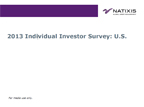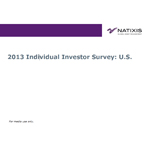BOSTON--(BUSINESS WIRE)--Most American investors are optimistic that their finances will improve in the next year, and the vast majority are confident that their current investment approach has them on track to meet their retirement savings goals. However, less than half say they have a financial plan, and those who do may be significantly underestimating the amount they will need in retirement, according to a survey released today by the Natixis Global Asset Management (NGAM) Durable Portfolio Construction Research Center.
“The slow recovery we’re seeing could be derailed by any number of challenges,” said John T. Hailer, chief executive officer of Natixis Global Asset Management in the Americas and Asia. “It’s important to be invested regardless of the market cycle. Going forward, we need to do all we can to encourage investors to put plans in place and to provide strategies that can help them meet their goals while managing volatility. This will help investors stay invested over the long term.”
NGAM, one of the world’s largest asset managers, surveyed more than 750 investors in the United States as part of its annual global investor survey. The survey included more than 5,650 investors in 14 countries from Asia, Europe, the Americas, the Middle East and the United Kingdom.
Investors are seeking new strategies, including alternative investments
Seventy-six percent of investors say they are interested in products unrelated to the performance of the broader markets, and most investors (61%) do not believe the traditional equities/bond approach to portfolio allocation is the best way to pursue returns and manage investments.
“We advocate for building durable portfolios, which begins by evaluating a person’s tolerance for market volatility and long-term goals,” said Hailer. “It’s important to start by focusing on what really matters – the overall level of risk in a portfolio. Using this strategy, a portfolio’s structure would combine a core mix of stocks, bonds and alternative investments that would be designed to keep volatility within an investor’s predetermined range.”
Almost three out of four investors (72%) say they would consider alternative investments if their advisor recommended them, and 74% say advisors are increasingly discussing alternatives with them. This latter figure represents a sizable increase from the 2011 survey, when 19% of investors said advisors were discussing alternatives with them, and from 2012, when 35% said the same.
A focus on Durable Portfolio Construction can help address investors’ planning needs; help them navigate various risks – including threats to their retirement savings; and help provide them with some clarity on a reasonable asset allocation strategy.
Lack of planning and underestimating needs may create challenges for investors
Americans are generally optimistic, with more than half (53%) expecting that their financial situations will improve over the next 12 months. Many (89%) are also confident that their current investment strategy has them on pace to meet their retirement savings goals. Most (54%), however, say they don’t have a financial plan, and 45% say they don’t even have clear financial goals.
Those who do have plans estimate they will need 62% of their pre-retirement income to live in retirement – significantly less than the 70% to 80% commonly used for planning purposes.1
While investors may not be saving enough, they are thinking ahead about potential costs in retirement, including long-term healthcare. Americans expect they will need five years of long-term care and are confident they will be prepared to meet these costs. Nevertheless, 40% of U.S. investors consider long-term care costs not covered by insurance to be the biggest threat to their financial security in retirement.
Investors’ Top Ten Financial Threats to Retirement
- Long-term care costs not covered by insurance: 40%
- Significant reduction in retirement savings or investments due to market conditions: 36%
- Insufficient proceeds from defined-contribution plan: 27%
- Unemployment: 22%
- Physically incapable of working: 21%
- Insufficient proceeds from my pension or defined-benefit plan: 20%
- Cost of college education for my child/children: 19%
- Insufficient sale proceeds from primary residence: 16%
- Cost of caring for children/grandchildren: 16%
- Cost of caring for elderly family members: 15%
If their retirement funds fall short and they are incapable of supporting themselves, 40% of investors say they will rely on family members to fill the gap, and 38% will look to government programs. Nineteen percent said they would rely on post-retirement work.
Increased anxiety about political, economic and disaster risks
Investors are growing increasingly concerned about the political and macroeconomic landscape and how it affects their investments. Nearly all (94%) investors say they are anxious about the federal government’s financial situation, with 57% saying they are “very concerned.” Ninety-two percent are concerned about the level of unemployment and 91% are concerned about U.S. political issues, including 45% who are “very concerned.” In addition, the majority of investors (78%) are anxious about the possibility of a natural disaster. Most investors are also concerned about the possibility of terrorism (88%) and war (82%).
Fortunately, investors remain focused on understanding the potential risk in their portfolios. In fact, eight in ten (80%) believe they understand risk and 56% say they understand it “fairly well.” Nearly all (86%) pay attention to the overall risk in their portfolios, and 82% actively try to measure the risk of their investments.
“It’s encouraging to see a strong focus on risk,” said Hailer. “We know from recent history that when investors are focused on growing assets without understanding the risks involved, it’s a recipe for disaster. Advisors and their clients have a chance this time to change the script by putting risk first in every investment decision.”
Investors unsure about asset allocation
Most investors (83%) say they strive for a balance between risk and return when making investment decisions, but 65% concede they sometimes cannot decide between pursuing return and simply preserving capital. If forced to choose, most investors (73%) would take safety over performance.
“This is particularly an issue for investors who are nearing retirement because interest rates on their savings accounts aren’t generating enough income and they are reluctant to invest because volatility in the market presents more risk than they can bear,” Hailer said.
These competing priorities are reflected in investors’ planned allocation adjustments in the coming year. Many plan to increase their allocations to defensive assets such as cash (36% plan to add), gold and other precious metals (28%) and real estate (28%). Some investors are showing a renewed appetite for growth. Twenty-eight percent plan to increase their weightings to U.S. stocks in the next 12 months, 22% expect to add to their weighting in alternative mutual funds and 20% plan to increase their exposure to both emerging market stocks and private equity.
“Ultimately, investors need the help of their financial advisors more than ever to assist in creating a portfolio that will generate income while minimizing risk,” said Hailer.
For more information from the Durable Portfolio Construction Research Center, see durableportfolios.com.
Methodology
Natixis Global Asset Management Global Investor Insights Survey conducted by CoreData Research (July 2013). Survey included 5,650 investors with 200K+ in assets (USD) in 14 countries from Asia, Europe, the Americas, and the Middle East.
About Natixis Global Asset Management, S.A.
Natixis Global Asset Management, S.A. is one of the 15 largest asset managers in the world based on assets under management.2 Its affiliated asset management companies provide investment products that seek to enhance and protect the wealth and retirement assets of both institutional and individual investor clients. Its proprietary distribution network helps package and deliver its affiliates’ products around the world. Natixis Global Asset Management, S.A. brings together the expertise of multiple specialized investment managers based in Europe, the United States and Asia to offer a wide spectrum of equity, fixed-income and alternative investment strategies.
Headquartered in Paris and Boston, Natixis Global Asset Management, S.A.’s assets under management totaled $783.3 billion (€602.5 billion) as of June 30, 2013.3 Natixis Global Asset Management, S.A. is part of Natixis. Listed on the Paris Stock Exchange, Natixis is a subsidiary of BPCE, the second-largest banking group in France. Natixis Global Asset Management, S.A.’s affiliated investment management firms and distribution and service groups include Absolute Asia Asset Management; AEW Capital Management; AEW Europe; AlphaSimplex Group; Aurora Investment Management; Capital Growth Management; Caspian Private Equity; Darius Capital Partners; Gateway Investment Advisers; H2O Asset Management; Hansberger Global Investors; Harris Associates; IDFC Asset Management Company; Loomis, Sayles & Company; McDonnell Investment Management; Natixis Asset Management; Ossiam; Reich & Tang Asset Management; Snyder Capital Management; Vaughan Nelson Investment Management; and Vega Investment Managers. Visit www.ngam.natixis.com for more information.
______________________________________
1 MacDonald, B-J., and K. D. Moore. 2011. “Moving Beyond the Limitations of Traditional Replacement Rates.” Society of Actuaries. www.soa.org/research/research-projects/pension/default.aspx.
2 Natixis Global Asset Management (NGAM) is the world’s 15th-largest asset manager based on global assets under management as of December 31, 2012, according to Cerulli Associates.
3 Assets under management (AUM) may include assets for which non-regulatory AUM services are provided. Non-regulatory AUM includes assets which do not fall within the SEC’s definition of ‘regulatory AUM’ in Form ADV, Part I.
The information contained herein is provided solely for information only and does not constitute a solicitation to buy or an offer to sell any financial products or services. This document may contain references to third party copyrights, indexes, and trademarks, each of which is the property of its respective owner. Such owner is not affiliated with Natixis Global Asset Management or any of its related or affiliated companies (collectively “NGAM”) and does not sponsor, endorse or participate in the provision of any NGAM services, funds or other financial products.
NGAM Distribution, L.P. is located at 399 Boylston Street, Boston, MA 02116.
Natixis Global Asset Management consists of Natixis Global Asset Management, S.A., NGAM Distribution, L.P., NGAM Advisors, L.P., NGAM S.A., and NGAM S.A.’s business development units across the globe, each of which is an affiliate of Natixis Global Asset Management, S.A. The affiliated investment managers and distribution companies are each an affiliate of Natixis Global Asset Management, S.A.
722599




